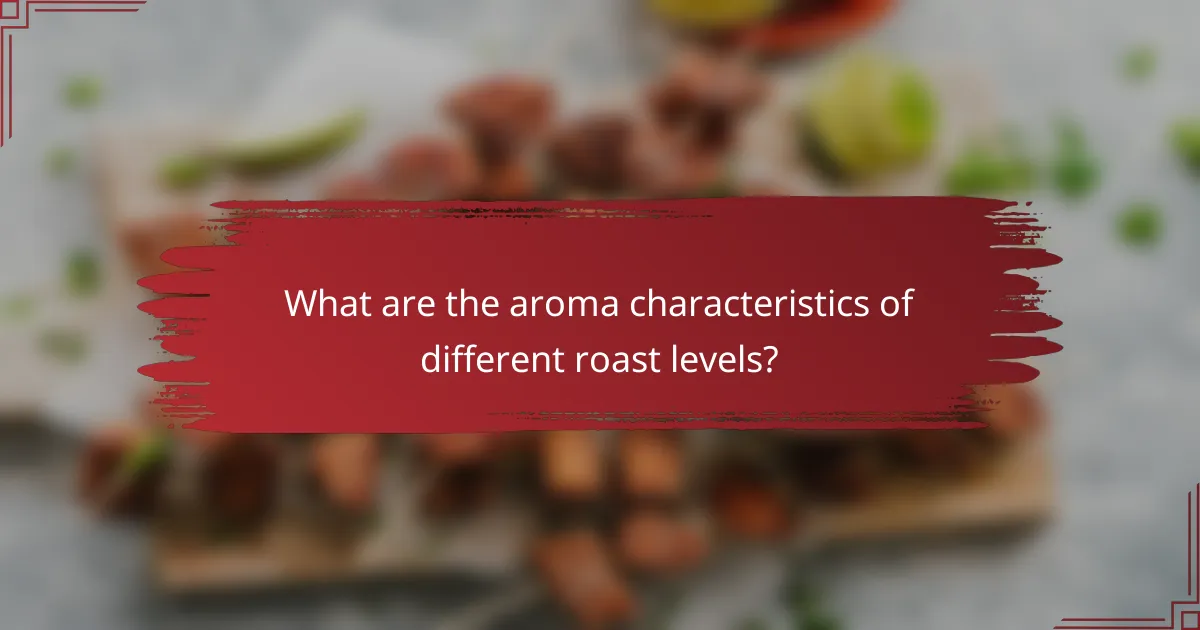The roast level of coffee plays a crucial role in shaping its flavor, aroma, and appearance. Each level—light, medium, and dark—offers a unique sensory experience, with variations in taste ranging from bright acidity to rich bitterness. Additionally, the color of the beans serves as a visual cue to their roast level, further influencing the overall quality and enjoyment of the brew.

How does roast level affect flavor in coffee?
The roast level of coffee significantly influences its flavor profile, aroma, and color. Different roast levels create distinct taste experiences, ranging from bright and acidic to deep and bitter.
Light roast enhances acidity and brightness
Light roasts are known for their vibrant acidity and bright flavors. This roast level preserves the natural characteristics of the coffee beans, often highlighting fruity or floral notes.
Common flavor descriptors for light roasts include citrus, berry, and herbal. These coffees typically have a lighter body and a more pronounced acidity, making them ideal for those who enjoy a lively cup.
Medium roast balances sweetness and body
Medium roasts strike a balance between acidity and sweetness, creating a well-rounded flavor profile. This roast level often brings out caramel and chocolate notes, appealing to a wide range of coffee drinkers.
With a medium body and moderate acidity, these coffees are versatile and can be enjoyed in various brewing methods. They are often favored for their smoothness and complexity.
Dark roast adds bitterness and depth
Dark roasts are characterized by their bold flavors, often featuring a pronounced bitterness and deep, rich undertones. The roasting process caramelizes the sugars in the beans, resulting in flavors like dark chocolate, smoke, and even a hint of spice.
These coffees typically have a fuller body and lower acidity, making them a popular choice for espresso and other strong brews. However, the intense flavors may not appeal to everyone, especially those who prefer lighter profiles.

What are the aroma characteristics of different roast levels?
The aroma characteristics of coffee vary significantly across different roast levels, influencing the overall flavor profile. Light, medium, and dark roasts each present unique scents that can enhance or alter the drinking experience.
Light roast features floral and fruity notes
Light roasts are known for their bright and vibrant aromas, often highlighting floral and fruity notes. These coffees typically retain more of the original bean’s characteristics, resulting in scents reminiscent of citrus, berries, and even jasmine.
When selecting a light roast, look for beans sourced from regions like Ethiopia or Kenya, where these flavor profiles are more pronounced. Brewing methods such as pour-over or Aeropress can further accentuate these delicate aromas.
Medium roast offers nutty and caramel aromas
Medium roasts strike a balance between the bright notes of light roasts and the deeper scents of dark roasts. They often present nutty and caramel aromas, creating a rich and smooth drinking experience.
This roast level is versatile, making it suitable for various brewing methods, including drip coffee and French press. Beans from Central America, such as those from Guatemala or Costa Rica, often exhibit these desirable characteristics.
Dark roast presents smoky and chocolate scents
Dark roasts are characterized by their bold and robust aromas, featuring smoky and chocolate scents. The roasting process brings out deeper flavors, often overshadowing the original bean’s characteristics.
When choosing a dark roast, consider beans from regions like Sumatra or Brazil, which typically deliver these rich aromas. French press or espresso methods work well to extract the full-bodied flavors of dark roasts, enhancing their smoky and chocolate notes.

What colors indicate different roast levels?
The color of coffee beans is a key indicator of their roast level, which affects flavor, aroma, and overall quality. Generally, lighter roasts are light brown, medium roasts are medium brown, and dark roasts range from dark brown to almost black.
Light roast is light brown
Light roast coffee beans are characterized by their light brown color, often with no oil on the surface. This roast level retains more of the bean’s original flavors, resulting in a brighter, more acidic taste profile.
Common varieties of light roast include Cinnamon and New England roasts. These coffees typically have a lighter body and showcase floral and fruity notes, making them popular among those who prefer a more delicate flavor.
Medium roast is medium brown
Medium roast beans are medium brown and may have a slight sheen due to the presence of oils. This roast level strikes a balance between acidity and body, offering a more rounded flavor profile.
Popular types of medium roast include American and Breakfast roasts. These coffees often feature a mix of sweetness and acidity, appealing to a wide range of coffee drinkers who enjoy a well-rounded cup.
Dark roast is dark brown to almost black
Dark roast coffee beans are dark brown to nearly black, with an oily surface that indicates a longer roasting time. This roast level tends to have a bold, rich flavor with lower acidity and pronounced bitterness.
Examples of dark roasts include French and Italian roasts. These coffees often exhibit deep chocolate and smoky flavors, making them ideal for those who prefer a robust and intense coffee experience.

How to choose the right roast level for your taste?
Choosing the right roast level for your coffee involves understanding how different roasts affect flavor, aroma, and color. Light, medium, and dark roasts each offer distinct characteristics that can enhance your coffee experience based on your personal preferences.
Consider flavor preferences
Your flavor preferences play a crucial role in selecting a roast level. Light roasts typically present bright, fruity, and floral notes, while medium roasts balance acidity with sweetness, offering a more rounded flavor profile. Dark roasts, on the other hand, provide bold, rich flavors with chocolatey or smoky undertones.
To identify your preferred flavors, consider trying a variety of roasts. A tasting flight of different roast levels can help you pinpoint which flavors resonate with your palate.
Evaluate brewing methods
The brewing method you choose can significantly influence the taste of your coffee and how roast levels are perceived. For instance, lighter roasts often shine in pour-over or Aeropress methods, where their nuanced flavors can be fully appreciated. In contrast, dark roasts may work better in espresso or French press, where their boldness can stand up to the brewing process.
Experimenting with different brewing techniques can help you discover how roast levels interact with your chosen method, enhancing your overall coffee enjoyment.
Assess caffeine content needs
Caffeine content varies with roast levels, but not in the way many think. While lighter roasts have slightly more caffeine by weight, the difference is minimal. If you’re looking for a caffeine boost, consider your brewing method and serving size rather than solely focusing on roast level.
For a higher caffeine content, opt for a lighter roast brewed using methods like cold brew, which can yield a stronger cup. Conversely, if you prefer a smoother taste with lower caffeine, a medium or dark roast might be more suitable.

What are the best coffee brands for each roast level?
The best coffee brands vary by roast level, each offering distinct flavor profiles and aromas. Light roasts tend to highlight the coffee’s origin, medium roasts balance acidity and sweetness, while dark roasts provide a bold, rich flavor.
Stumptown Coffee Roasters for light roast
Stumptown Coffee Roasters is renowned for its light roast offerings, which emphasize bright acidity and complex flavors. Their Hair Bender blend is a popular choice, showcasing notes of citrus and chocolate.
When selecting a light roast from Stumptown, consider brewing methods like pour-over or Aeropress, which enhance the coffee’s delicate flavors. Avoid brewing at too high a temperature to preserve the nuanced taste.
Peet’s Coffee for medium roast
Peet’s Coffee excels in medium roasts, providing a balanced flavor profile that appeals to a wide audience. Their Major Dickason’s Blend is a favorite, combining rich body with a smooth finish.
For medium roasts, aim for a brewing temperature around 200°F (93°C) to extract the best flavors. This roast level is versatile, suitable for drip coffee makers or French presses, making it an excellent choice for everyday coffee drinkers.
Death Wish Coffee for dark roast
Death Wish Coffee is famous for its dark roast, known for its intense caffeine content and bold flavor. This brand offers a deep, smoky taste that is perfect for those who prefer a strong cup of coffee.
When brewing dark roasts like Death Wish, use a coarser grind and a slightly shorter brewing time to avoid bitterness. This roast is best enjoyed in a French press or espresso machine, where its robust flavors can shine.

How does roast level impact coffee brewing?
The roast level of coffee significantly influences its flavor profile, aroma, and appearance. Lighter roasts tend to preserve more of the bean’s original characteristics, while darker roasts develop richer, bolder flavors through the roasting process.
Flavor Impact
The flavor impact of roast level is profound, affecting acidity, sweetness, and bitterness. Light roasts often exhibit bright acidity and fruity notes, while medium roasts balance sweetness and acidity, creating a smoother profile. Dark roasts, on the other hand, tend to have a pronounced bitterness with deep, smoky flavors.
When brewing, consider the roast level to enhance your desired flavor profile. For instance, a light roast might be best suited for pour-over methods, which highlight its delicate flavors, whereas a dark roast may shine in espresso, where its boldness can stand up to milk or sugar.
Aroma
Aroma is closely tied to roast level, with each stage of roasting releasing different aromatic compounds. Light roasts often have floral or fruity aromas, while medium roasts develop nutty or caramel notes. Dark roasts can produce rich, chocolatey or even burnt aromas.
To maximize aroma during brewing, use freshly ground coffee and ensure your brewing equipment is clean. The right grind size and brewing temperature can also enhance the aromatic experience, especially for lighter roasts.
Color
The color of roasted coffee beans ranges from light brown to nearly black, corresponding to the roast level. Light roasts are typically light brown with no oil on the surface, medium roasts are a richer brown with some oil beginning to appear, and dark roasts are dark brown to black with a shiny, oily surface.
When selecting coffee, consider how the color reflects the roast level and the expected flavor. For example, if you prefer a bright, acidic cup, opt for a light roast. Conversely, if you enjoy a bold, full-bodied coffee, a dark roast may be more suitable.



